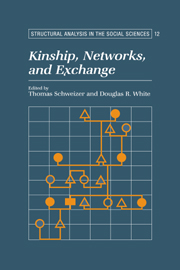Book contents
- Frontmatter
- Contents
- Preface
- List of contributors
- 1 Revitalizing the Study of Kinship and Exchange with Network Approaches
- I Representing Kinship Dynamics, Material Flow, and Economic Cooperation
- II Individual Embeddedness and the Larger Structure of Kinship and Exchange Networks
- III Marriage, Exchange, and Alliance: Reconsidering Bridewealth and Dowry
- 9 Wealth Transfers Occasioned by Marriage: A Comparative Reconsideration
- 10 Prestations and Progeny: The Consolidation of Well-Being among the Bakkarwal of Jammu and Kashmir (Western Himalayas)
- 11 “We Don't Sell Our Daughters”: A Report on Money and Marriage Exchange in the Township of Larantuka (Flores, E. Indonesia)
- IV Emergence, Development, and Transformation of Kin-Based Exchange Systems
- Index
11 - “We Don't Sell Our Daughters”: A Report on Money and Marriage Exchange in the Township of Larantuka (Flores, E. Indonesia)
Published online by Cambridge University Press: 05 November 2011
- Frontmatter
- Contents
- Preface
- List of contributors
- 1 Revitalizing the Study of Kinship and Exchange with Network Approaches
- I Representing Kinship Dynamics, Material Flow, and Economic Cooperation
- II Individual Embeddedness and the Larger Structure of Kinship and Exchange Networks
- III Marriage, Exchange, and Alliance: Reconsidering Bridewealth and Dowry
- 9 Wealth Transfers Occasioned by Marriage: A Comparative Reconsideration
- 10 Prestations and Progeny: The Consolidation of Well-Being among the Bakkarwal of Jammu and Kashmir (Western Himalayas)
- 11 “We Don't Sell Our Daughters”: A Report on Money and Marriage Exchange in the Township of Larantuka (Flores, E. Indonesia)
- IV Emergence, Development, and Transformation of Kin-Based Exchange Systems
- Index
Summary
INTRODUCTION
Talking about marriage, people in Larantuka often contrast their own practice with that in the Lamaholot culture of East Flores: Lamaholot people have bridewealth (bélis) and, therefore, “sell” their daughters, whereas in Larantuka this does not happen. Actually, at Larantuka marriages quite substantial sums of money are transferred to the parents of the bride, whereas in Lamaholot society prestations tend to take the form of valuables (tusks, textiles) with no money involved. What is more, within the asymmetric alliance system of Lamaholot society, bridewealth is reckoned as a debt, and it is paid “in such a way that several are settled simultaneously and in a chain; so that the payment travels in a circle and the debts of several lines are mutually canceled, making it unnecessary to secure actual goods for payment” (Barnes 1977: 151; cf. Graham 1991:153, 162–5; Kennedy 1955:47). In other words those who “sell” daughters do not use money, and transfer of goods may be only nominal. Those who do not “sell” daughters receive substantial sums of cash – in 1991, Rp. 500,000 was considered as common, Rp. 1,000,000 as rather frequent, and at one marriage Rp. 2,300,000 was involved (the sums corresponded to ca. U.S. $250, $500, and $1,150, respectively). In addition to the marriage cash payment and in preparation for the marriage itself, a simple though extensive exchange network (kumpo-kao), based again on cash, is activated.
- Type
- Chapter
- Information
- Kinship, Networks, and Exchange , pp. 234 - 244Publisher: Cambridge University PressPrint publication year: 1998
- 2
- Cited by



